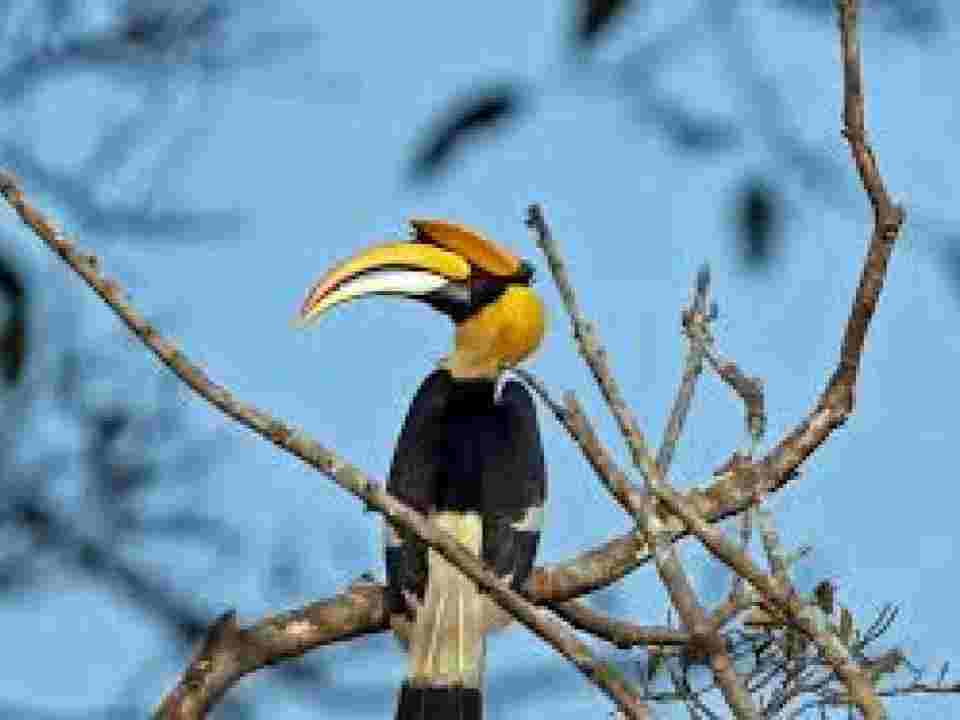Description
In a remarkable and unusual observation, the Great Hornbill known locally in Kerala as the Malamuzhakki Vezhambal and celebrated as the State Bird of Kerala was recently sighted in the coastal region of Kakkampara, near Ezhimala in Kannur district. This location lies outside its typical forested range, making the sighting particularly significant for ornithologists and conservationists.
Overview Of Great Hornbill
The Great Hornbill (scientific name: Buceros bicornis), also known as the Great Indian Hornbill or Great Pied Hornbill, is among the largest members of the hornbill family. It is widely admired for its striking appearance, unique nesting behavior, and important ecological role as a seed disperser in tropical forests.
Geographical Distribution
This iconic bird is native to the Indian subcontinent and Southeast Asia. In India, populations are primarily concentrated in two main regions:
The Western Ghats, particularly in the states of Kerala, Karnataka, and Tamil Nadu
The forests along the Himalayan foothills, extending from Uttarakhand to Arunachal Pradesh
The recent sighting in Kakkampara, a coastal, non-forested area, is unusual as the species typically resides in dense, old-growth forests, making this movement possibly linked to habitat changes or search for food.
Natural Habitat And Behavior
Great Hornbills thrive in wet evergreen and moist deciduous forests, typically between elevations of 600 to 2,000 meters. They prefer nesting in tall, mature trees that rise above the forest canopy, as these provide safety and visibility.
They are primarily frugivorous, relying heavily on figs and other tropical fruits, but they are also opportunistic feeders. Occasionally, they consume small mammals, reptiles, and birds, playing a dual role in the ecosystem as both seed dispersers and secondary predators.
Physical Characteristics
These birds are easily recognizable due to their impressive size, vivid coloration, and unique casque:
Length: 95 to 120 cm
Wingspan: 151 to 178 cm
Weight: Around 3 kg on average
Coloration: The plumage is mostly black with white on the neck and underparts. The tail is white with a distinctive black band near the tip.
A prominent feature is the casque, a hollow structure on top of the beak, more developed in males and used for displays and combat. Another notable feature is the gland near the tail, which produces a yellowish to reddish oil used for grooming, sometimes giving the bird a brightly colored appearance.
Sexual dimorphism is subtle but visible:
Males have red irises, larger bills, and casques
Females display white irises
Both sexes have distinct eyelashes, a trait common among hornbills.
Ecological And Cultural Significance
The Great Hornbill plays a crucial ecological role by dispersing seeds of various forest trees, thereby supporting forest regeneration. In cultural contexts, it holds symbolic value in several indigenous traditions across India and Southeast Asia and is celebrated in folklore and rituals.
In Kerala, it is revered as the State Bird, symbolizing the state’s rich biodiversity.
Conservation Status And Threats
The species is currently listed as Vulnerable on the IUCN Red List, primarily due to:
Deforestation and habitat fragmentation
Illegal hunting, often for its casque and feathers
Loss of nesting trees, as old-growth forests disappear
Conservation efforts are underway in several parts of India, including habitat protection, community engagement, and eco-tourism awareness initiatives to ensure the survival of this iconic species.
Conclusion
The unexpected appearance of a Great Hornbill in the Kakkampara coastal belt serves as a reminder of the species’ adaptive behavior and possibly highlights shifting ecological patterns due to climate or habitat changes. It also underscores the importance of preserving natural habitats, even beyond known forest regions, to protect such majestic wildlife.
Welcome to Notopedia.com, your free learning platform that caters to the diverse needs of students and aspirants across a spectrum of entrance exams and educational endeavors. Whether you're preparing for highly anticipated exams like CAT, NEET, JEE Main, or bank job vacancies, our platform offers a wealth of resources to guide you towards success. Stay up-to-date with the latest exam dates, announcements, and results for various government recruitment exams, including SSC CGL, CHSL, NDA, and UPSC. Explore comprehensive study materials, sample papers, and exam patterns to hone your skills and boost your confidence. From important dates like CBSE Class 10 and 12 date sheets to exam-specific information like JEE Main application form date, we cover it all. Notopedia.com is your go-to source for everything from admissions and admit cards to scholarships and college information. Whether you're aiming for a career in defense, government, banking, or higher education, our free learning platform equips you with the knowledge and resources you need to excel. Join us in your educational journey and unlock a world of opportunities, guidance, and comprehensive support.
For more Updates and Information - Visit Notopedia's Bulletin Board
For Latest Sarkari Jobs - Visit Notopedia's Sarkari Jobs Section
For access to more than 20,000 Colleges - Visit Notopedia's College Section
For School Studies and Exams Preparation across 14 Boards - Visit Notopedia's School Section
For Comprehensive Preparation of Sarkari Job Exams - Visit Notopedia's Sarkari Exams Section










